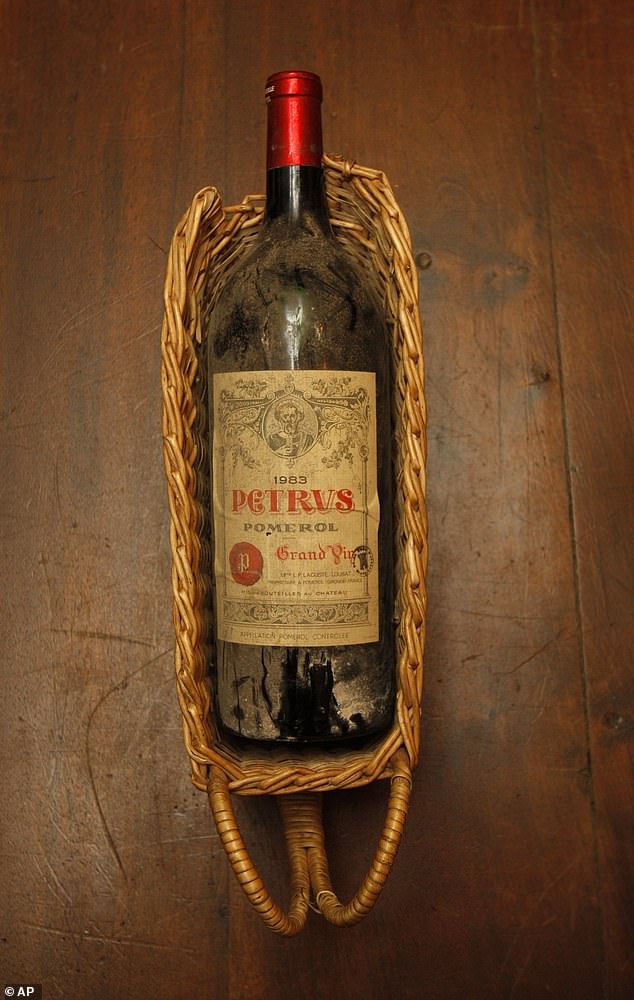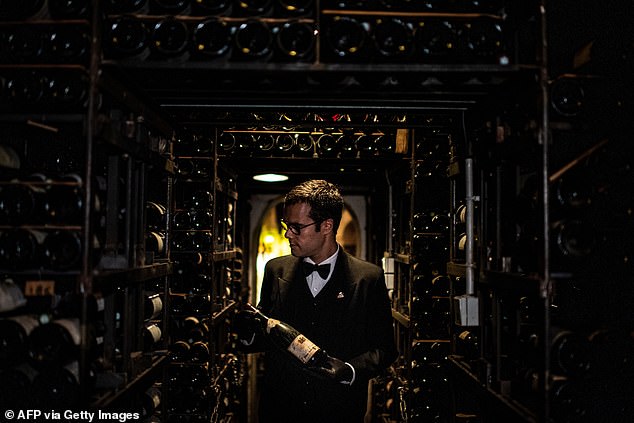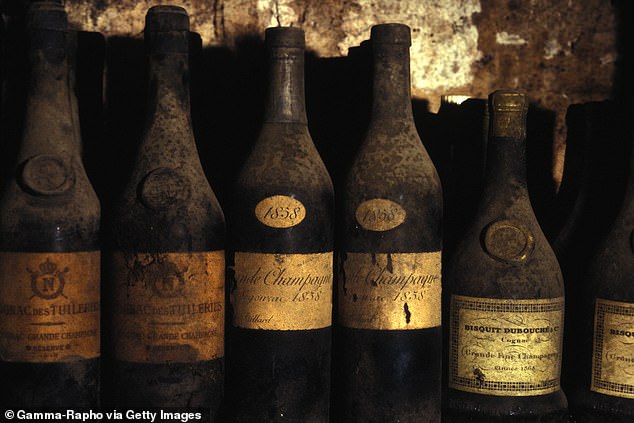How thieves walked away with £1.3m of fine wines from top Paris restaurant that hosts the world’s biggest celebrities, has a metal-lined cellar – and even repelled the Nazis
The wine cellar of La Tour d’Argent, Paris’s oldest restaurant, is so revered that only customers who order the most expensive vintages or otherwise ‘prove their interest’ are given a tour.
Members of the lucky ones are then escorted to the inside of the restaurant by a staff member in white tie and tails, who ceremoniously rings a brass bell to announce the visitor’s arrival to the security people who monitor the contents 24 hours a day.
Once there, they are confronted with a warren of 27 rooms containing more than 300,000 bottles with a combined value of £21 million.
The 25,000 most valuable bottles, all priced at £250 or more, are stored in a special room on the first floor of the cellar, where the walls are reinforced with warship-quality metal to prevent thieves from getting in, and no one – even not the head sommelier – only allowed in there.
That makes it all the more shocking that a routine inventory carried out last month revealed that 83 bottles of some of the rarest wines, with a combined value of more than £1.3 million, were missing.
There were no signs of forced entry and the only thing we know for sure, according to the restaurant, is that the theft could have happened at any time in the last four years.
La Tour d’Argent was awarded three Michelin stars in 1933 and held them for more than half a century – and the sixth floor dining room offered spectacular views of Notre Dame
The Third Department of the Paris Judicial Police has an eye on the case, but with the trail colder than the constant temperature of 54F (or 12C) at which La Tour wines are kept, no one can trust the highly discerning burglars – you could say they are a first class crew – will be brought to justice.
Call me Maigret, but the fact that the restaurant underwent extensive renovations for over a year before reopening last summer seems to indicate an enterprising oenophile among the team of builders, or someone in a position to take advantage of the disruption to sneak away. a succession of beautiful vintages.
And what treasures they were. A list of the missing bottles includes a number of red Burgundies from the prestigious Domaine de la Romanee-Conti, home to some of the world’s largest wine producers.
Wine merchant Berry Brothers lists a 2010 grand cru at £30,000 a bottle. And that is the retail price. Restaurants in Paris mark up wine as much as five or six times the purchase price.
It’s not the first time that La Tour, which reached a new audience after being revealed as the inspiration for the 2007 hit film Ratatouille, the story of a young rodent who fulfills his dreams of becoming a chef at a famous eatery in the French capital. , has had problems with greedy kleptomaniacs.
In the book Wine And War: The French, The Nazis, And The Battle For France’s Greatest Treasure, authors Donald and Petie Kladstrup describe how in June 1940 – within days of the Germans occupying Paris – an envoy of Field Marshal Hermann Goring asked for to see the cellar.
In the following months, the Nazis disposed of as many as 80,000 bottles. They would have taken many more if not for the quick thinking of Claude Terrail, who ran the restaurant until 2003 before leaving it to his son André.

The restaurant’s reputation for serving the best wines in the world has never wavered
On the night the Nazis entered the city, he personally built a brick wall that had the effect of creating a secret basement cellar, behind which he stored 20,000 of the restaurant’s finest wines.
After the end of the war, the restaurant – which translates as The Silver Tower – rebuilt its collection and celebrated its reopening last year with a ‘wine bible’ that weighed a whopping 9 kg and is wheeled to guests’ tables. a cart.
Because the menu was equally highly regarded – La Tour was awarded three Michelin stars in 1933 and held for more than half a century – and the sixth-floor dining room offered spectacular views of Notre Dame and Sacre Coeur, it attracted a wide range of star-studded stars. from customers.
Famous dinner parties included our late Queen (as Princess Elizabeth in 1948), Charlie Chaplin, Salvador Dali, Sir Mick Jagger, Prince, Robert De Niro, Dustin Hoffman, Brad Pitt and Angelina Jolie. In one memorable week, Bill Clinton and Boris Yeltsin both showed up (separately, not together).
Many will have ordered La Tour’s signature dish, canard au sang, or bloody duck, invented by 19th-century owner Frederic Delair.
Widely regarded as the most succulent breed available, Challans ducks are raised on the restaurant’s own farm in western France before being slaughtered by strangulation so that no blood is lost, and delivered to the train the same day be sent to Paris.
In the restaurant’s kitchen, they are picked and gutted – leaving only the liver, heart and gizzard – and partially roasted.
The duck is then sent to a preparation table in the center of the restaurant, where the breast, legs and liver are removed and the skin is set aside.
The carcass – skin, bones and all – is placed in a solid silver duck press, designed by blue chip tableware company Christofle, to release the blood and marrow juice.
These are then thickened and flavored with the duck liver – which has been mashed – and mixed with cognac and madeira.

A sommelier in the basement of the Parisian restaurant, which has 27 rooms with more than 300,000 bottles worth a combined £21 million
The resulting sauce is unctuous and very strong in flavor, with a muddy brown appearance. In short, not to everyone’s taste.
It was Delair’s bright idea to give each customer who ordered the dish a numbered certificate, a practice that continues to this day.
The future Emperor of Japan, Hirohito, was given number 53,211 in 1921, President Roosevelt number 112,151 and Marlene Dietrich number 203,728. The restaurant celebrated its millionth duck in 2003 and the total is now said to have reached the 1.2 million mark.
This has proven to be a very profitable business over the years: today the ‘Duck Frederic Delair’ costs 370 euros for two.
Tragedy struck in 1996 when Michelin reduced La Tour’s rating to two stars and when it was further reduced to one star ten years later, it was considered such an earth-shattering event that TV crews spent days outside the entrance to the venue. restaurant camped.
But the country’s reputation for serving the world’s best wines has never been shaky, and for 37 years the man overseeing La Tour’s annual wine purchasing budget was not French, but – quelle horreur! – an Englishman.

Some bottles in the cellar of La Tour, which has an annual wine purchasing budget of £1 million
The son of a Surrey antiques dealer, Derek Ridgway began his career as a 19-year-old in 1975 at the Waterside Inn in Bray before moving abroad, first to Germany and then to France, where he applied for a job at La Tour purely on the basis that he had once eaten there.
Within a year he was head sommelier – at the age of 26. “There is no age on talent,” Claude Terrail once said in defense of his controversial appointment. ‘It’s a gift from heaven. I don’t care if he’s English. All I care about is how he does his job.”
When Ridgway took over in 1981, the 100-page wine list consisted of 1,000 wines. By the time he left in 2018, it was 400 pages, with 15,000 wines.
There was one glaring omission, however: one terrible day, a now ex-employee broke the oldest bottle in the cellar, an 1811 Chateau Lafite.
“He did something chaotic with a kick and hit it on the ground,” Ridgway once recalled. ‘How much was it worth? ‘I’d rather not think about it’
Who can blame him? An 1869 bottle of this beautiful Bordeaux sold at auction in 2010 for a world record price of £233,973.
Today, the restaurant’s oldest wine is another Bordeaux, a relatively spicy Chateau Leoville Barton from 1845.
Or was. It remains to be seen whether it was one of the targets of the robber or robbers, who pulled off one of the most lucrative wine heists ever.
